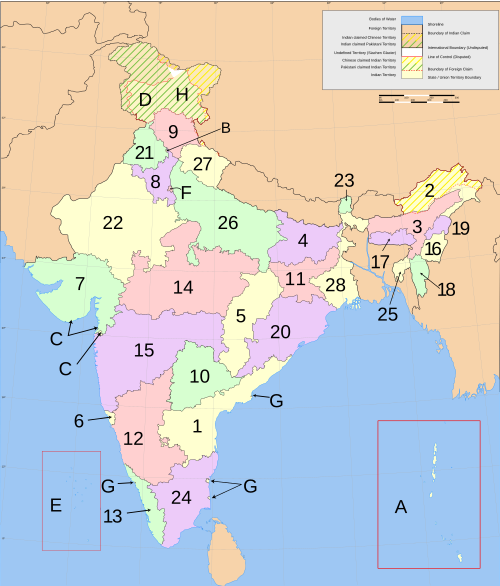India is a federal union of states comprising twenty-eight states and seven union territories. The states and territories are further subdivided into districts and so on.

Source: http://en.wikipedia.org/wiki/States_and_territories_of_India, http://en.wikipedia.org/wiki/Divisions_of_India
Date: 9 December 2012
Culture Zones
Source: http://en.wikipedia.org/wiki/Cultural_Zones_of_India
Date copied: 9 December 2012
The Cultural Zones of India are seven overlapping zones defined by the Ministry of Culture of the Government of India to promote and preserve the cultural heritage of various regions of India. Each of these zones has been provided with a zonal centre.Most zonal centres were announced by the then-Prime Minister of India, Rajiv Gandhi, in 1985 and formally began functioning in the 1986-87 period. Their stated goal is "to strengthen the ancient roots of Indian culture and evolve and enrich composite national culture".
| Zone | Zonal Centre | States in zone |
|---|---|---|
| South Culture Zone | Thanjavur, Tamil Nadu | Kerala, Taminnadu, Andhra Pradesh, Kamataka, UT Andaman & Nicobar Islands, Lakshdeep, Pondicherry |
| South Central Culture Zone | Nagpur, Maharashtra | Madhya Pradesh, Maharashtra, Kamataka & Andhra Pradesh |
| North Culture Zone | Patiala, Punjab | Himachal Pradesh, Jammu & Kashmir, Rajasthan, Harayana, Punjab, Uttrakhand, UT Chandigarh |
| North Central Culture Zone | Allahabad, Uttar Pradesh | Uttar Pradesh, Madhya Pradesh, Rajasthan, Harayana, Uttaranchal, Bihar & Delhi |
| East Culture Zone | Kolkata, West Bengal | West Bengal, Bihar, Orissa, Assam, Tripura, Manipur, Sikkim, Jharkhand, UT Andaman & Nicobar Islands |
| North East Culture Zone | Dimapur, Nagaland | Arunachal Pradesh, Assam, Manipur, Meghalaya, Mizoram, Nagaland, Sikkim, Tripura |
| West Culture Zone | Udaipur, Rajasthan | Goa, Gujarat, Rajasthan, Maharashtra, UT Daman, Due, Dadra, Nagar Haveli |
States
| # | Code | Name | Capital |
|---|---|---|---|
| 1 | AP |
|
Hyderabad |
| 2 | AR |
|
Itanagar |
| 3 | AS |
|
Dispur |
| 4 | BR |
|
Patna |
| 5 | CT |
|
Raipur |
| 6 | GA |
|
Panaji |
| 7 | GJ |
|
Gandhinagar |
| 8 | HR |
|
Chandigarh |
| 9 | HP |
|
Shimla |
| 10 | JK |
|
Srinagar |
| 11 | JH |
|
Ranchi |
| 12 | KA |
|
Bengalooru |
| 13 | KL |
|
Thiruvananthapuram |
| 14 | MP |
|
Bhopal |
| 15 | MH |
|
Mumbai |
| 16 | MN |
|
Imphal |
| 17 | ML |
|
Shillong |
| 18 | MZ | Mizoram | Aizawl |
| 19 | NL | Nagaland | Kohima |
| 20 | OR |
|
Bhubaneswar |
| 21 | PJ |
|
Chandigarh |
| 22 | RJ |
|
Jaipur |
| 23 | SK | Sikkim | Gangtok |
| 24 | TN |
|
Chennai |
| 25 | TR | Tripura | Agartala |
| 26 | UP |
|
Lucknow |
| 27 | UT |
|
Dehradun |
| 28 | WB |
|
Kolkata |
Union Territories
| # | Code | Name | Capital |
|---|---|---|---|
| A | AN | Andaman and Nicobar Islands | Port Blair |
| B | CH | Chandigarh | Chandigarh |
| C | DN | Dadra and Nagar Haveli | Silvassa |
| D | DD | Daman and Diu | Daman |
| E | LD | Lakshadweep | Kavaratti |
| F | DL |
|
New Delhi |
| G | PY | Pondicherry | Pondicherry |